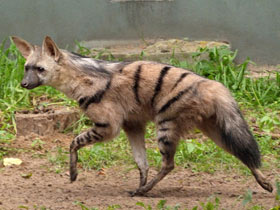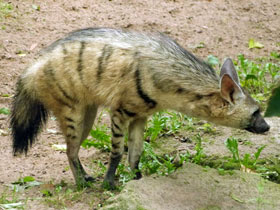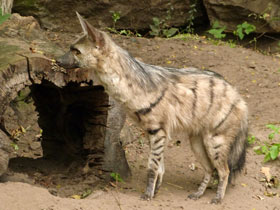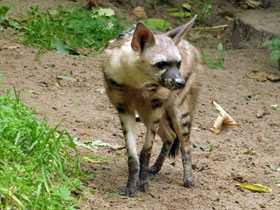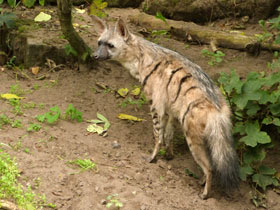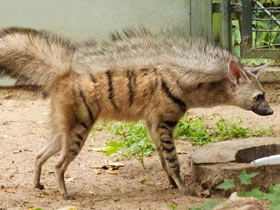The aardwolf (Proteles cristatus)
The aardwolf (Proteles cristatus) is an insectivorous species of hyena, native to East and Southern Africa. Its name means "earth-wolf" in Afrikaans and Dutch. It is also called the maanhaar-jackal (Afrikaans for "mane-jackal"), termite-eating hyena and civet hyena, based on its habit of secreting substances from its anal gland, a characteristic shared with the African civet.
Unlike many of its relatives in the order Carnivora, the aardwolf does not hunt large animals. It eats insects and their larvae, mainly termites; one aardwolf can lap up as many as 300,000 termites during a single night using its long, sticky tongue. The aardwolf's tongue has adapted to be tough enough to withstand the strong bite of termites.
The aardwolf lives in the shrublands of eastern and southern Africa – open lands covered with stunted trees and shrubs. It is nocturnal, resting in burrows during the day and emerging at night to seek food.
Taxonomy
The aardwolf is generally classified with the hyena family Hyaenidae, though it was formerly placed in its own family Protelidae. Early on, scientists felt that it was merely mimicking the striped hyena, which subsequently led to the creation of Protelidae. Recent studies have suggested that the aardwolf probably diverged from other hyaenids early on; how early is still unclear, as the fossil record and genetic studies disagree by 10 million years.
The aardwolf is the only surviving species in the subfamily Protelinae. There is disagreement as to whether the species is monotypic, or can be divided into subspecies Proteles cristatus cristatus of Southern Africa and Proteles cristatus septentrionalis of East Africa.
A 2006 molecular analysis indicates that it is phylogenetically the most basal of the four extant hyaenidae species.
Etymology
The generic name proteles comes from two words both of Greek origin, protos and teleos which combined means "complete in front" based on the fact that they have five toes on their front feet and four on the rear. The specific name, cristatus, comes from Latin and means "provided with a comb", relating to their mane.
Appearance
Proteles cristata somewhat resembles Hyaena hyaena in appearance, but is much smaller: body length is only 55-95 cm, tail length 20-30 cm and shoulder height 45-50 cm. Adults weigh between 8 and 14 kg, depending on seasonal food availability. There is no sexual dimorphism in size. Another difference with hyenas is that Proteles cristata have 5 (instead of 4) toes on their front legs.
The physique of Proteles cristata is more delicate than that of true hyenas; the limbs are tall and rather slender, the neck long; the forelimbs are longer than the hind limbs, but the slope of the back is not as pronounced as that of hyenas.
Proteles cristata has a dog-like head, elongated and with a narrow muzzle. The coat is coarse and consists of a long, thick undercoat and a soft, twisted undercoat. It has long hair growing from the back of the head to the rump, forming a mane that rises to a peak in case of danger, making Proteles cristata appear larger. The ground wolf has the longest upper body fur of any mammal of prey, growing from 7 cm at the back of the head to 20 cm at the shoulders, and 16 cm at the tail.
The coat colour of Proteles cristata is light yellowish-grey to reddish; the throat and lower body are paler, greyish-white. Contrasting patterns usually consist of 3 transverse and 1-2 diagonal black stripes on the flanks and many transverse stripes on the legs.
The tail of Proteles cristata is fluffy, with black stripes; its tip is black; black stripes and spots are also sometimes visible on the neck; on the muzzle the hairs are short (10-15 mm long) and sparse, grey; the tip of the muzzle is naked and black.
This animal has 5 toes on the front legs and 4 on the hind legs; they are equipped with strong, non-retractable claws.
The eyes are quite large; the ears are large and pointed. Wide tongue; the saliva secreted by the large submandibular glands, as in all thermophagous animals, is sticky. The jaws of Proteles cristata are disproportionately strong, with sharp fangs, but due to its feeding habits the molars are simplified and sparsely arranged. Proteles cristata needs its powerful chewing muscles and sharp fangs to fight off rivals and potential predators. The anal glands, similar in structure to those of hyenas, are well developed.
Habitat area
Proteles cristata is common in eastern and southern Africa. Its range is fragmented by the tropical forests of Zambia and southern Tanzania, where the species is not found. Thus, one population of the ground wolf is found in southern Africa (South Africa, Lesotho, Swaziland, Namibia, Botswana, Zimbabwe, southern Angola, southern Zambia and south-western Mozambique). The other, more northerly population is found from central Tanzania through north-eastern Uganda, Kenya, Somalia, along the coast of Ethiopia, Eritrea and Sudan, to the south-eastern tip of Egypt. It inhabits dry, open plains (with an annual rainfall of 100-800 mm) and may be found in agricultural land. In general, the marmot's range coincides with that of termites of the family Hodotermitidae, which inhabit grassy plains and savannahs.
Lifestyle
Proteles cristata are solitary, but often live in monogamous pairs that aggressively defend their feeding grounds, which vary in size from 1 to 4 km² depending on food availability.
Typically, each feeding area contains about 3,000 termites, 55,000 insects each. The perimeter of the feeding area is marked with yellowish-orange excretions from the anal glands, which quickly turn black in the air due to oxidation. Within the feeding areas, near the dens and latrines, scent marks are also placed. Both males and females mark territory, although males do so more frequently.
Proteles cristata is active at dusk and at night, and only in South Africa in winter does it switch to diurnal activity, which corresponds to the activity of its main food, termites. When feeding, Proteles cristata moves at about 1.7 km/h, travelling 8-12 km (in summer) or 3-8 km (in winter) during the night.
During the day, Proteles cristata usually hides in underground shelters, usually in old tubeworms' burrows (which are built near termites), and in empty burrows of porcupines and long-nosed animals.
However, Proteles cristata may also dig their own burrows. Proteles cristata may have up to a dozen burrows in an area they occupy, which they maintain for an average of 6 to 8 weeks, and change afterwards.
Nutrition
Unlike true hyenas, Proteles cristata does not feed on carrion, but on termites and occasionally on other insects and their larvae (especially dead beetles, which it collects from dead animals) and spiders.
In winter (June-July) the South African Proteles cristata undergoes a period of starvation, losing up to 20% of its body weight. Winter is also the period of highest mortality among juveniles.
Unlike other termite eaters, Proteles cristata does not destroy termites, but waits for them to surface and licks them from the ground, using its broad, sticky tongue. This explains the peculiarities of its diet: Trinervitermes are the only termites that regularly come to the surface for most of the year to feed.
A single Proteles cristata can eat between 200,000 and 300,000 termites per night, which amounts to about 105,000,000 termites per year. Proteles cristata have few competitors; other termite eaters (Trichoptera, Great Red Fox) eat termites of the genus Trivitermes much less frequently. Occasionally, Proteles cristata captures small ground-nesting rodents and birds, or eats their eggs.
Its diet also includes some plant foods.
This animal does not depend on water sources, obtaining its liquid from termites. The only time ground wolves seek water sources is during prolonged cold periods in winter.
Proteles cristata are exclusively solitary feeders; only mature hatchlings can be observed feeding with adults, but 4-month-old hatchlings feed alone most of the time.
Social behaviour and reproduction
Proteles cristata form monogamous pairs. However, if the male is unable to defend his territory, the female mates with a more dominant male, although the young are subsequently guarded by their permanent mate. Pregnancy lasts about 90 days, and the female bears 2-4 cubs (although litters of 1-5 cubs have been observed in zoos). In South Africa cubs are born between October and December; the breeding season is less pronounced in warmer northern regions (Botswana, Zimbabwe).
Cubs remain in the den for 3-4 weeks; the den is changed about once a month. The cubs are handled by both parents.
For 3 months, the male protects the territory from predators and spends about 6 hours guarding the den at night while the female feeds.
Females whose dens are guarded by males have produced an average of 1.5 pups per year, i.e. 3 times more than females alone.
Until 9 weeks of age, cubs do not stray more than 30 m from the den. At 12 weeks of age, cubs begin to accompany their parents to feed, but still do not go further than 300-500 m from the den.
At 4 months of age, nursing ceases and the pups switch to self-feeding, but remain with their parents until the next breeding season, i.e. for 1 year.
At 2 years of age, young Proteles cristata reach sexual maturity.
In captivity, Proteles cristata has a lifespan of 13-15 years; in the wild, it is estimated to live about 10 years.
Conservation
The aardwolf has not seen decreasing numbers and is relatively widespread throughout eastern Africa. They are not common throughout their range, as they maintain a density of no more than 1 per square kilometer, if food is abundant. Because of these factors, the IUCN has rated the aardwolf as least concern. In some areas, they are persecuted because of the mistaken belief that they prey on livestock; however, they are actually beneficial to the farmers because they eat termites that are detrimental. In other areas, the farmers have recognized this, but they are still killed, on occasion, for their fur. Dogs and insecticides are also common killers of the aardwolf.
In captivity
Frankfurt Zoo in Germany was home to the oldest recorded aardwolf in captivity at 18 years and 11 months.

















